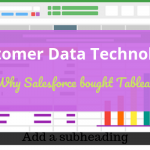
5 Considerations for Choosing Location-based Data for Marketing
Time to read: 3 minutes
Mobile marketing, empowered by location-based data, is big. According to BIA/Kelsey, mobile advertising alone is nearly $20 billion in 2018. Big markets mean marketers have a lot of location-based data choices.
While we’re still a long way from advertising burgers to passersby, underlying platforms continue to make huge improvements. So how do marketers choose a type of geo-targeting known as location-based data?
As always, know your marketing goal. While location-based data is most commonly used in advertising, marketers can benefit from it in other ways.
Location-based Data: More Than Just for Advertising
For instance, it’s great for insights. You can learn new customer insights by knowing where customers go. After all, where they go shows what they do. It’s also useful for competitive insights. Just as you can learn about your customers, you can learn about competitors’ customers too.
Location-based data also helps with other marketing challenges. It measures impact of marketing programs on visits & engagement, and supports marketing events and campaigns.
So choosing a location data source depends on which one is most suitable for your goals. It depends on who you want to reach. Also, the the size of your consumer base. And whether it’s for insights or a campaigns. If it’s for a marketing campaign, what’s the stage of the funnel? Is it to drive awareness, consideration or purchase?
Next scrutinize the location-based data to really understand what it is.
Know Details of Provider’s Location-based Data
You have to understand the details to make the right choice. Not all data providers are the same. Take the time to learn and pick the the source that best matches your goals. In particular, spend time to understand these 5 criteria:
#1. How much it’s verified and validated
Seek to understand the process a vendor uses to verify that their data is correct.
#2. As real-time as possible
There are trade-offs with this one. A shorter-refresh interval means a small target audience while a longer interval results in a much larger one. The level of importance for this factor really depends on your product and how often it’s purchased. OF course, if you’re using location-based data for customer insights, it’s much less important.
#3. Precise as possible
For example, can it tell the difference from being in the parking lot versus the stadium or the shopping center?
#4. Works with contextual data
Every marketer knows it’s helpful to know consumer demographics and characteristics. Know how a location-based data sources supplies more intelligence than just location alone.
For example, does it come with its own first-party set of contextual characteristics? Does it, or at least have the ability to, merge with other third-party data sources to know more characteristics of the mobile device owner? Chances are that you’ll need to merge location-based data with an audience from another data vendor. Select either a marketing data management provider (DMP) to meet your marketing goal or a Demand Side Provider (DSP) to complete your advertising campaign.
#5. Segments into consumer groups
In this case, does your data provider create clusters of consumers? It’s important so you can identify and reach new customers that look like your current best customers.
In sum, choosing location-based data requires that you’re clear on your marketing goal. Next, understand how data providers construct target audiences. Then choose your marketing audience data from a DMP or buy ads using a DSP.
As usual, test, test, test. It’s the only way to find the right combination of goal, location-based data and right third-party marketing data from a DMP or DSP. We think that that organizations need to get familiar with location-based and geotargeting because it’s certain to be as important, if not MORE important, than social media advertising.
In the meantime, happy experimenting!
Hey, know anyone lost in the marketing wilderness? Location-based data helps! Give a brother a hand and share this blog!








